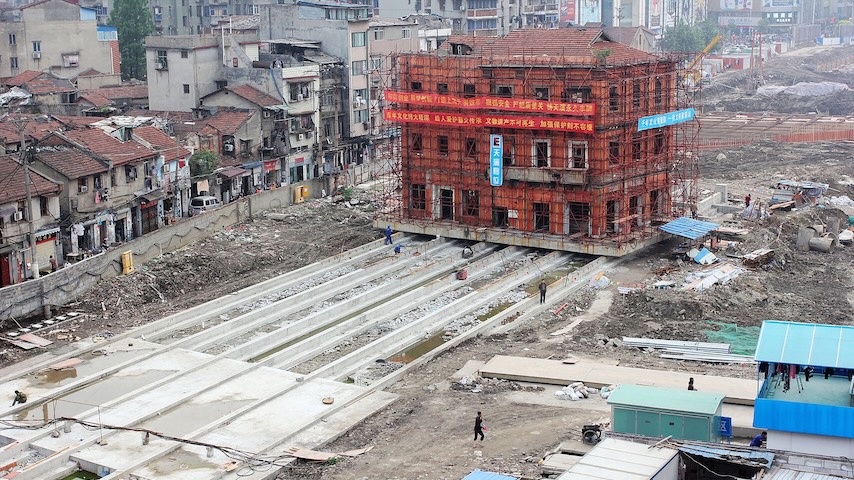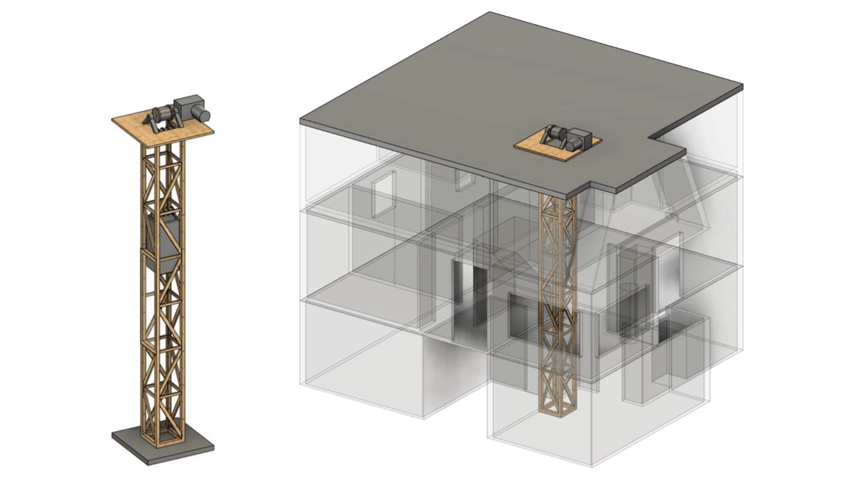5 Buildings That Trekked
5 Buildings That Trekked


Why rebuild a building when you can move it? Here are five unique buildings that were moved intact for one reason or another.
There are multiple reasons why buildings are relocated, from historical preservation to disaster prevention. Sometimes they’re moved simply because it’s cheaper than building something new. But engineers have been moving built structures for centuries.
Technology has greatly advanced from the early 1700s, when buildings were moved with the help of horses and logs—today, self-propelled modular transporters make this challenging process just a little bit easier.
While most buildings that are moved nowadays are houses, there are some standout relocations that have moved some massive structures in recent years. Here’s a look at five of those.
Fu Gang Building
The current Guinness World Record holder for “heaviest building moved intact” is the Fu Gang Building in Guangxi Province, China. Guangzhou Luban Corporation set out to move the 15,140.4 metric ton (33.3 million pound) building horizontally by 35.62 meters, a process that took 11 days in November 2004. Crews moved the 111-foot-tall structure to clear the path for a new road.
Owned by the Hankou Yiyong Fire Association, this historic building was mostly gutted internally and shored up externally before being jacked up and guided down a set of tracks to its new position.
Building 51
Newark Airport’s Building 51 was originally a passenger terminal when completed in 1935. Eventually, as the airport expanded, it was repurposed for offices in the 1970s and renamed Building 51. But after plans came together for a runway expansion, airport officials decided the 9,000-ton structure would be moved 3,700 feet so it could serve as administration space.
To do that, crews detached and moved the east and west wings separately before jacking the 6,000-ton center section up eight feet with a unified jacking machine before placing it onto about 200 rubber tire dollies. This made Building 51 the heaviest structure ever moved in the world on rubber tire dollies, according to Prismatic Development Corp., which performed the move in 2001.
Church of the Assumption of the Virgin Mary
First built in the city of Most in the Czech Republic, this gothic church is all that remains of the town, which was demolished to make way for coal mining in the 1960s and 1970s. Given the church’s historical and architectural value, the country’s Ministry of Culture tasked an expert committee to oversee its relocation.
In preparation for the 841-meter move, the church was heavily reinforced—steel beams were installed to support the internal columns as well as the exterior, while a concrete ring was placed around the building’s base. Crews excavated two trenches below the church and installed two railway lines between the original and new sites. Now weighing about 12,000 tons, the church made its way along the track with the help of four large hydraulic jacks on a journey that began in late September 1975 and lasted 28 days.
Oerlikon Building
When it was first built in 1889, this three-story building in Zurich, Switzerland was the home of Maschinenfabrik Oerlikon, a manufacturer of machine tools, weapons, and locomotives. In 2012, the facility’s new owner ABB first planned to demolish the facility to make way for a new railway line, but after the public petitioned to save the landmark for its cultural and regional significance, the decision was made to move the building 60 meters.
Doing so required the addition of steel supports and shifting the building onto a steel frame that sat on 500 steel rollers across six rails. Hydraulic jacks propelled the 6,200-ton structure to its new location over the course of 19 hours—and the move was broadcast on local television.
Shanghai Concert Hall
Originally dubbed the Nanking Theatre (then Beijing Cinema in 1949 and Shanghai Concert Hall in 1959), this venue was first built in the 1930s. But as the city of Shanghai continued to grow and highways began to rise nearby, outdoor noises soon plagued the concert hall. Instead of simply building a new space, in 2003, the city chose to move the Shanghai Concert Hall to preserve both its acoustic abilities and its architectural significance (as one of the few buildings of its time to be designed by a Chinese architect, Fan Wenzhao). It was also moved to allow for construction of a new elevated roadway.
Since the building had a mixed foundation design, engineers decided to place an 1,800-ton reinforced concrete tray under the concert hall, which allowed for 59 hydraulic jacks and four hydraulic pump stations to lift the building up 1.7 meters. It was then moved 66.4 meters along 10 custom concrete tracks, which took about 12 days.
Louise Poirier is senior editor.










